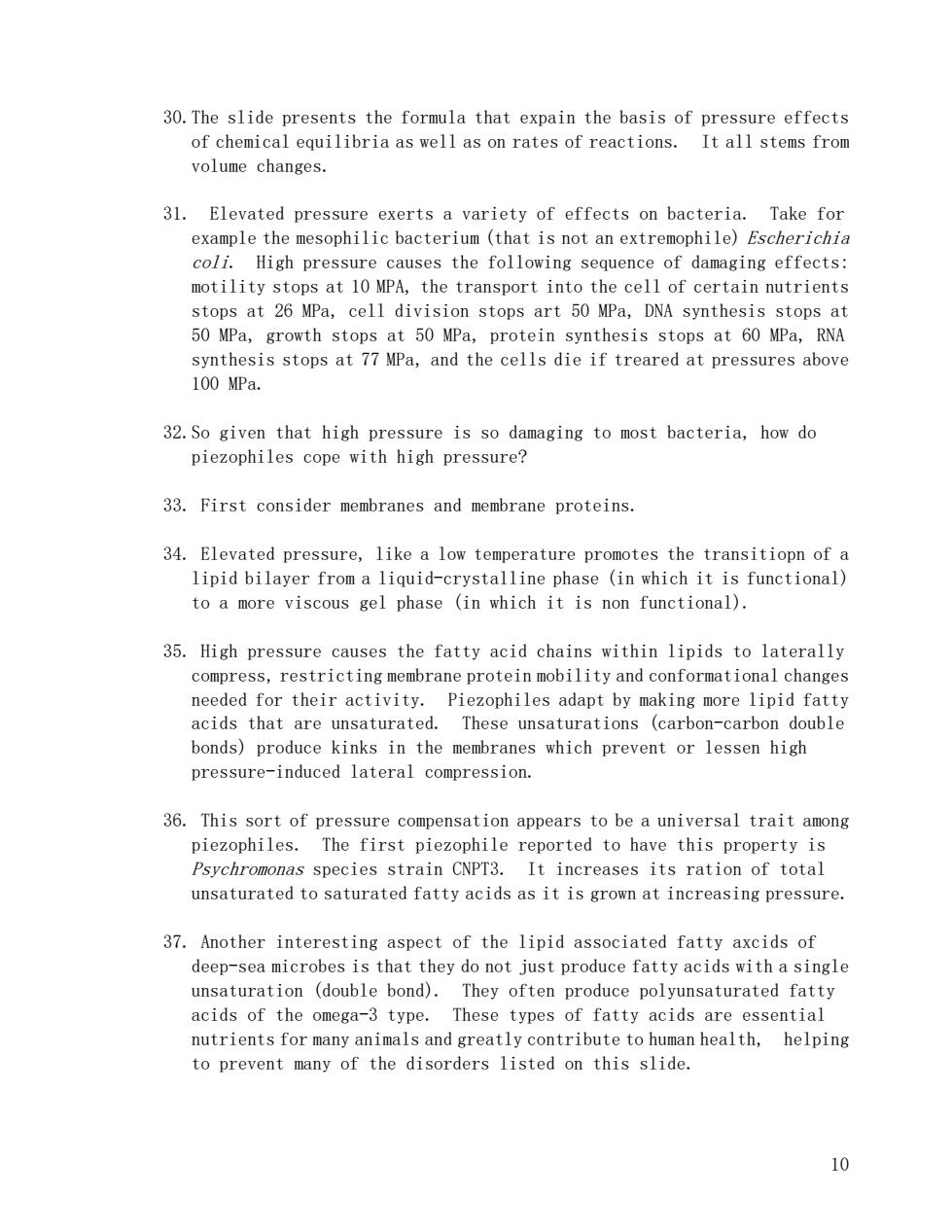正在加载图片...

30.The slide presents the formula that expain the basis of pressure effects of chemical equilibria as well as on rates of reactions.It all stems from volume changes. 31.Elevated pressure exerts a variety of effects on bacteria.Take for example the mesophilic bacterium (that is not an extremophile)Escherichia coli.High pressure causes the following sequence of damaging effects: motility stops at 10 MPA,the transport into the cell of certain nutrients stops at 26 MPa,cell division stops art 50 MPa,DNA synthesis stops at 50 MPa,growth stops at 50 MPa,protein synthesis stops at 60 MPa,RNA synthesis stops at 77 MPa,and the cells die if treared at pressures above 100 MPa. 32.So given that high pressure is so damaging to most bacteria,how do piezophiles cope with high pressure? 33.First consider membranes and membrane proteins. 34.Elevated pressure,like a low temperature promotes the transitiopn of a lipid bilayer from a liquid-crystalline phase (in which it is functional) to a more viscous gel phase (in which it is non functional). 35.High pressure causes the fatty acid chains within lipids to laterally compress,restricting membrane protein mobility and conformational changes needed for their activity.Piezophiles adapt by making more lipid fatty acids that are unsaturated.These unsaturations (carbon-carbon double bonds)produce kinks in the membranes which prevent or lessen high pressure-induced lateral compression. 36.This sort of pressure compensation appears to be a universal trait among piezophiles.The first piezophile reported to have this property is Psychromonas species strain CNPT3.It increases its ration of total unsaturated to saturated fatty acids as it is grown at increasing pressure. 37.Another interesting aspect of the lipid associated fatty axcids of deep-sea microbes is that they do not just produce fatty acids with a single unsaturation (double bond).They often produce polyunsaturated fatty acids of the omega-3 type.These types of fatty acids are essential nutrients for many animals and greatly contribute to human health,helping to prevent many of the disorders listed on this slide. 1010 30.The slide presents the formula that expain the basis of pressure effects of chemical equilibria as well as on rates of reactions. It all stems from volume changes. 31. Elevated pressure exerts a variety of effects on bacteria. Take for example the mesophilic bacterium (that is not an extremophile) Escherichia coli. High pressure causes the following sequence of damaging effects: motility stops at 10 MPA, the transport into the cell of certain nutrients stops at 26 MPa, cell division stops art 50 MPa, DNA synthesis stops at 50 MPa, growth stops at 50 MPa, protein synthesis stops at 60 MPa, RNA synthesis stops at 77 MPa, and the cells die if treared at pressures above 100 MPa. 32.So given that high pressure is so damaging to most bacteria, how do piezophiles cope with high pressure? 33. First consider membranes and membrane proteins. 34. Elevated pressure, like a low temperature promotes the transitiopn of a lipid bilayer from a liquid-crystalline phase (in which it is functional) to a more viscous gel phase (in which it is non functional). 35. High pressure causes the fatty acid chains within lipids to laterally compress, restricting membrane protein mobility and conformational changes needed for their activity. Piezophiles adapt by making more lipid fatty acids that are unsaturated. These unsaturations (carbon-carbon double bonds) produce kinks in the membranes which prevent or lessen high pressure-induced lateral compression. 36. This sort of pressure compensation appears to be a universal trait among piezophiles. The first piezophile reported to have this property is Psychromonas species strain CNPT3. It increases its ration of total unsaturated to saturated fatty acids as it is grown at increasing pressure. 37. Another interesting aspect of the lipid associated fatty axcids of deep-sea microbes is that they do not just produce fatty acids with a single unsaturation (double bond). They often produce polyunsaturated fatty acids of the omega-3 type. These types of fatty acids are essential nutrients for many animals and greatly contribute to human health, helping to prevent many of the disorders listed on this slide